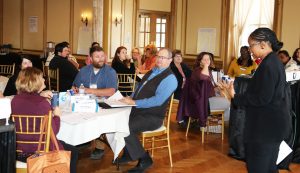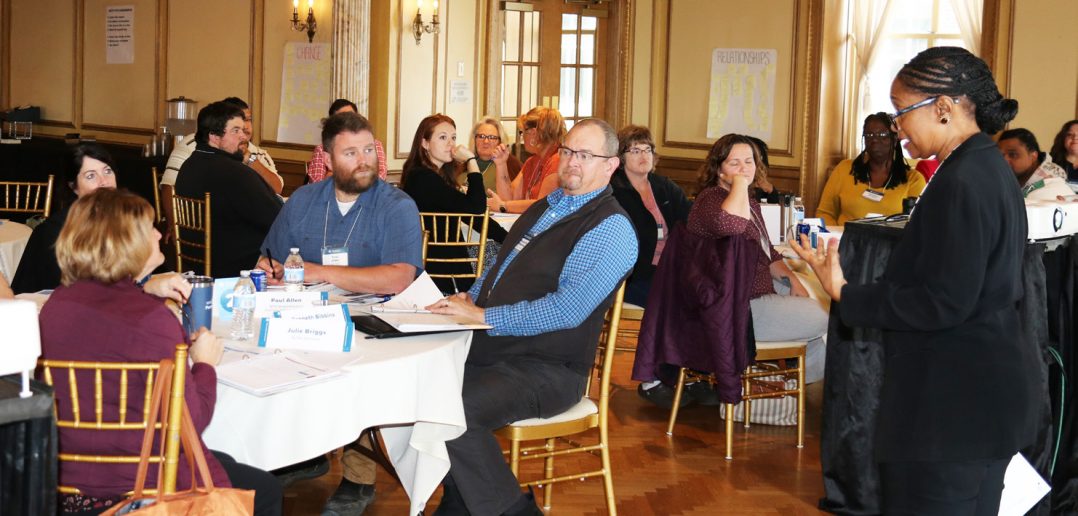
CSEA leaders and their management counterparts learn about their workplace styles using the DiSC personal assessment.
SYRACUSE — When it comes to working with union members or with management, people have different styles of interaction that may occasionally clash with one another.
With the goal of improving their working relationships, CSEA local officers from several state agencies joined with their management counterparts for a recent training through New York State & CSEA Partnership’s Labor Management Co-Chair Institute (LMCI).
Participants were able to develop skills in leadership and self-awareness to empower their labor-management committees, apply strategies for resolving conflict and assess their committee’s abilities and how to maximize its potential.
The training included a DiSC Self-Assessment to help identify their leadership styles and learn best practices for working with others with different styles. The DiSC assessment has been used by many employers for more than 50 years to help workers better understand themselves and each other to improve working relationships.

Regg
“It was a great way to learn about our differences and similarities and figure out a better way to work together,” said SUNY Oneonta Local President Jenn Regg. “It was enlightening and nice to get people together because we were able to draw on each other’s experiences and perspectives.”
Different styles form relationships
The DiSC assessment helped shine a light on participants’ workstyle preferences. According to the original theory, people show their emotions using four behavior types: dominance, inducement, submission and compliance.
The dominant, or “D,” style is all about taking action and getting results. People in this category are goal oriented. However, these people can come across as brash as they often take control of situations.

Central Region activist Kalah Quinn participates in the training.
The Inducement, or ‘i,” style is depicted as the ‘cheerleader’ type. This category highlights workers who have strong social skills and are enthusiastic and optimistic. These workers sometimes also show impulsivity, which can hinder getting to the end goal.
The Submission, or “S,” style is defined as workers who are very supportive of others, are team players and cooperate to get the work done. However, these workers risk getting taken advantage of by others.
The Compliance, or “C,” style is shown in people who take a logic-based approach and value accuracy. However, these workers can be overly critical of other people and themselves.
“You figure you’re 43 years old and you would know yourself pretty well,” said Regg. “I always knew I was kind of a ‘put out the fire’ type of person, but I never realized how much that encompassed my personality. I enjoy helping people so much and I don’t need too much information to jump into something.”
In addition to learning their work style preference, attendees also learned how to improve their working relationships with other people, whether they have similar or differing styles.
After taking the assessment, participants processed their results on their own before coming back together to devise a plan to address how to better work together.

Kiuber
“The DiSC program was a great asset to the labor-management world,” said Workers’ Compensation Board Local President Michele Kiuber, who also participated. “It provided insight and tools to help identify and work better with the various personalities.”
After getting her assessment results, Regg said she reflected on her relationship with a co-worker at SUNY Oneonta with whom she occasionally butts heads.

SUNY Geneseo Local 1st Vice President Jesse Beardsley addresses the room.
“I think he’s more of a ‘needs facts, numbers, and evidence’ type of person, whereas, I’m more of a take action kind of person,” said Regg. “When someone brings to me an issue, I spring into action. I don’t need to see the quantitative data before I jump. I feel like that’s a big difference in our personalities. After seeing the assessment and learning the different personalities and how their brains worked, it was just eye-opening.”
It was so eye-opening that her management counterpart said she wished that all labor-management committee members would take the assessment so they could learn how each other think and operate.
“(The training) was just a good way to learn more about our differences and similarities and figure out a better way to work together,” said Regg. “It was nothing mandatory, so it was nice to see a good number of people there. That’s just reassuring that we’re all trying to better things for the greater good.”
— Nicholas Newcomb and Therese Assalian




